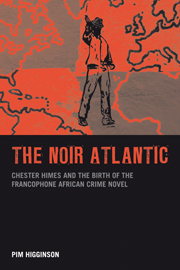Book contents
- Frontmatter
- Contents
- Acknowledgements
- Introduction: The Frivolous Literary
- 1 “Pas de littérature”: Abasse Ndione and the Rise of Crime
- 2 Minor Mistranslations: Simon Njami and the Making of a Parisianist Himes
- 3 Crime Pays: Achille Ngoye and the Série noire
- 4 Ethnographic Erotics: Bolya and the Writing of the Other
- 5 Terreur Rose: Kouty, mémoire de sang and the Gendering of Noir
- 6 Going out Blazing: Mongo Beti's Last Two Novels
- Bibliography
- Index
1 - “Pas de littérature”: Abasse Ndione and the Rise of Crime
- Frontmatter
- Contents
- Acknowledgements
- Introduction: The Frivolous Literary
- 1 “Pas de littérature”: Abasse Ndione and the Rise of Crime
- 2 Minor Mistranslations: Simon Njami and the Making of a Parisianist Himes
- 3 Crime Pays: Achille Ngoye and the Série noire
- 4 Ethnographic Erotics: Bolya and the Writing of the Other
- 5 Terreur Rose: Kouty, mémoire de sang and the Gendering of Noir
- 6 Going out Blazing: Mongo Beti's Last Two Novels
- Bibliography
- Index
Summary
“Pas de littérature!”
Abasse Ndione, La Vie en spiraleWhile crime fiction has existed in Francophone Africa at least since Félix Couchoro's serialized detective fiction of the 1940s, La Vie en spirale (1984; 1988), by Senegalese author Abasse Ndione, inaugurates the contemporary African hard-boiled novel of the type that Himes experimented with thirty years earlier. Ndione's tale focuses on three of the areas of importance to the genre: the specific relationship of the individual and his material accoutrements to space (through sociological definition and movement); the spatial-temporal specificity of language and the relationship of this largely oral vernacular to the process (and possession) of writing; and the relationship between the local and the global mediated through criminality. The material world of guns, cars, human bodies, gold/cash defines—and circulates through—a local yet cosmopolitan urban landscape (streets, buildings) and is represented in a sociologically defining literary vernacular thereby becoming a hard-boiled criminal “poetry … that transcends its time.” Interestingly, Ndione is the only author not influenced by Himes in any documentable way. Rather, the clear structural and aesthetic similarities between Himes and Ndione first suggest that the transnational path of the crime novel is not the conscious imitation of a model; rather, Francophone Africa's appropriation of the crime genre also corresponds to a distinct aesthetic need. Additionally, although African crime authors after Ndione primarily appeared in France, La Vie en spirale was originally published by Nouvelles Éditions africaines du Sénégal (NEAS), in Senegal, and was a tremendous success with its Senegalese reading public; among the authors in this study, Abasse Ndione and Mongo Beti are the only ones to write explicitly for an African audience.
- Type
- Chapter
- Information
- The Noir AtlanticChester Himes and the Birth of the Francophone African Crime Novel, pp. 39 - 68Publisher: Liverpool University PressPrint publication year: 2011



